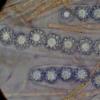
29-12-2025 17:44
Isabelle CharissouBonjour,J'aimerais savoir si d'autres personnes au

01-01-2026 18:35
Original loamy soil aside a artificial lake.The co

31-12-2025 19:27
Collected from loamy soil, at waterside (completel

30-12-2025 16:44
Pascal DucosBonjour,Une anamorphe rose stipitée, très nombre

30-12-2025 17:14
 Bernard CLESSE
Bernard CLESSE
Bonjour à toutes et tous,Pourriez-vous aider Albe

29-12-2025 10:15
Hulda Caroline HolteHello, I found and collected this propoloid ascom

30-12-2025 09:04
Hello.A Pyrenomycete sprouting sparsely but very d
Lamprospora ? laquelle ?
Isabelle Charissou,
29-12-2025 17:44
J'aimerais savoir si d'autres personnes auraient observé des Lamprospora sur Fissidens; des apothécies collectées le 25 décembre montrent des spores à verrues grossières (mais certaines spores semblent avoir diffirentes tailles de verrues), spores : environ 15 micron de diamètre; 5-6 verrues sur le diamètre et environ 13 sur le périmètre.
Jointe deux photos pas fameuses
Bonne fin d'année !
Nicolas VAN VOOREN,
29-12-2025 17:57

Re : Lamprospora ? laquelle ?
Ça ressemble aux spores de Lamprospora tuberculata, mais cette espèce vient sur Pleuridium.
Il y a de bons spécialistes des bryoparasites sur ce forum, je suis certain qu'ils pourront donner un meilleur éclairage.
Il y a de bons spécialistes des bryoparasites sur ce forum, je suis certain qu'ils pourront donner un meilleur éclairage.
Isabelle Charissou,
29-12-2025 18:29
Re : Lamprospora ? laquelle ?
Merci, c'est l'espèce qui semblait ressembler, mais il n'y avait pas de Pleuridium dans les parages...
Georges Greiff,
29-12-2025 21:29
Re : Lamprospora ? laquelle ?
Bonjour Isabelle,
L. bulbiformis on F. viridulus is close but the warts seem slightly higher here. Do you know which Fissidens species it could be on?
L. bulbiformis on F. viridulus is close but the warts seem slightly higher here. Do you know which Fissidens species it could be on?
Isabelle Charissou,
30-12-2025 08:46
Re : Lamprospora ? laquelle ?
Bonjour,
je pense qu'il s'agit de Fissidens crispus (=limbatus), sur sol argileux (sur schiste ardoisier) dans le sud Corrèze.
Merci de votre avis !
je pense qu'il s'agit de Fissidens crispus (=limbatus), sur sol argileux (sur schiste ardoisier) dans le sud Corrèze.
Merci de votre avis !
Isabelle Charissou,
03-01-2026 15:10
Re : Lamprospora ? laquelle ?
Hi, in fact, the moss seems to be Fissidens viridulus, although it has not all viridulus characters; it should be neighboring the former F. subimmaginatus (cor. P. Boudier).
So L bulbiformis with biger papillae ?
Have a nice day !
So L bulbiformis with biger papillae ?
Have a nice day !
Georges Greiff,
03-01-2026 15:22
Re : Lamprospora ? laquelle ?
Sounds like the best ID for now! A very nice collection.
George
George




